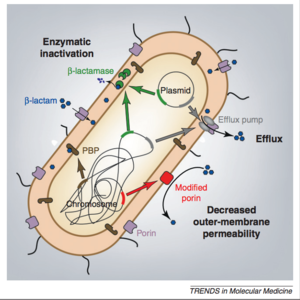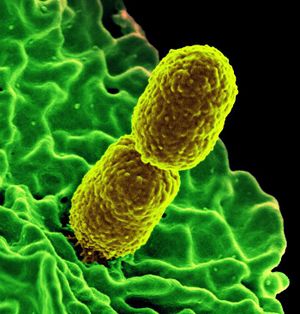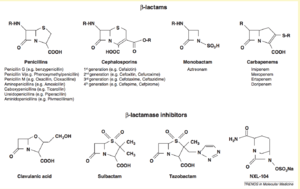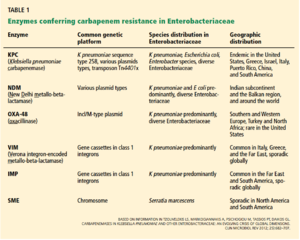Carbapenem-resistant Enterobacteriaceae (CRE): Difference between revisions
No edit summary |
No edit summary |
||
| Line 3: | Line 3: | ||
[[Image:Klebsiellapneumoniae.jpg|thumb|300px|right|Digitally-colorized scanning electron microscopic (SEM) image of Klebsiella pneumoniae (CRKP) bacteria, which are carbapenem-resistant. The two CRKP cells are interacting with human white blood cells. Image provided by Institute of Allergy and Infectious Diseases (NIAID). ]] | [[Image:Klebsiellapneumoniae.jpg|thumb|300px|right|Digitally-colorized scanning electron microscopic (SEM) image of Klebsiella pneumoniae (CRKP) bacteria, which are carbapenem-resistant. The two CRKP cells are interacting with human white blood cells. Image provided by Institute of Allergy and Infectious Diseases (NIAID). ]] | ||
[[Image:carbapenem.png|thumb|300px|right|Chemical structures of the main ß-lactams and ß-lactamases that are clinically available (3). ]] | [[Image:carbapenem.png|thumb|300px|right|Chemical structures of the main ß-lactams and ß-lactamases that are clinically available (3). ]] | ||
[[Image:resistance12.png|thumb|300px|right|Figure 2: Mechanisms of ß-lactam resistance in some species of Enterobacteriaceae. Porins allow for the uptake of antibiotics, but lack of these porins confers resistance. Efflux pumps confer resistance by pumping out antibiotics before they become effective. ß-lactamase is a hydrolyzing enzyme that breaks apart antibiotics before they can bind to PBP and disprupt the synthesis of the cell wall (3). ]] | |||
[[Image:enzymetable.png|thumb|300px|right|Table 1: Enzymes conferring carbapenem resistance in Enterobacteriaceae. ]] | |||
<br>By [My Name]<br> | <br>By [My Name]<br> | ||
<br>At right is a sample image insertion. It works for any image uploaded anywhere to MicrobeWiki.<br><br>The insertion code consists of: | <br>At right is a sample image insertion. It works for any image uploaded anywhere to MicrobeWiki.<br><br>The insertion code consists of: | ||
Revision as of 05:53, 25 April 2017
Section

By [My Name]
At right is a sample image insertion. It works for any image uploaded anywhere to MicrobeWiki.
The insertion code consists of:
Double brackets: [[
Filename: PHIL_1181_lores.jpg
Thumbnail status: |thumb|
Pixel size: |300px|
Placement on page: |right|
Legend/credit: Electron micrograph of the Ebola Zaire virus. This was the first photo ever taken of the virus, on 10/13/1976. By Dr. F.A. Murphy, now at U.C. Davis, then at the CDC.
Closed double brackets: ]]
Other examples:
Bold
Italic
Subscript: H2O
Superscript: Fe3+
Carbapenem-resistant Enterobacteriaceae (CRE) are a family of Gram-negative bacteria that are resistant to carbapenem, a class of anti-biotics used to treat infections. Carbapenems offer a broad-spectrum defense against a wide variety of both Gram-negative and Gram-positive bacteria, meaning that increasing resistance by CRE, to which there is no reliable treatment, is a major concern for the health industry. [2,3] Previously rare in the United States before 1992, CRE are becoming increasingly more common.[1] Although Enterobacteriaceae are normal human intestinal flora, resistance may be caused by the occurrence of hydrolyzing enzymes, such as serine β-lactamase KPC and the metallo–β-lactamase VIM.[3] Resistance to carbapenems is common in a number of Enterobacteriaceae, such as Kelbsiella pneumoniae and E. coli [3]. CRE typically cause infections in patients of hospitals and nursing homes [3]. The increasing prevalence and lack of reliable treatment have led many to predict CRE as the next "superbug." [3]
Introduce the topic of your paper. What is your research question? What experiments have addressed your question? Applications for medicine and/or environment?
Sample citations: [2]
[3]
A citation code consists of a hyperlinked reference within "ref" begin and end codes.
Section 1
Include some current research, with at least one figure showing data.
Every point of information REQUIRES CITATION using the citation tool shown above.
Section 2
Include some current research, with at least one figure showing data.
Section 3
Include some current research, with at least one figure showing data.
Section 4
Conclusion
References
Authored by Carter Powell for BIOL 238 Microbiology, taught by Joan Slonczewski, 2017, Kenyon College.
Edited by Carter Powell for BIOL 238 Microbiology, 2017, Kenyon College.
- ↑ Neil Gupta, Brandi M. Limbago, Jean B. Patel, Alexander J. Kallen; Carbapenem-Resistant Enterobacteriaceae: Epidemiology and Prevention. Clin Infect Dis 2011; 53 (1): 60-67. doi: 10.1093/cid/cir202
- ↑ Hodgkin, J. and Partridge, F.A. "Caenorhabditis elegans meets microsporidia: the nematode killers from Paris." 2008. PLoS Biology 6:2634-2637.
- ↑ Bartlett et al.: Oncolytic viruses as therapeutic cancer vaccines. Molecular Cancer 2013 12:103.



